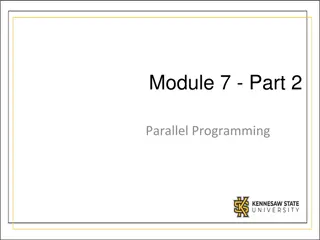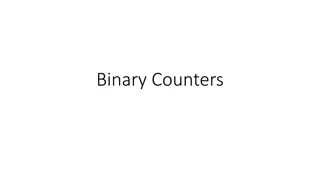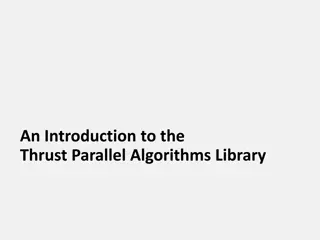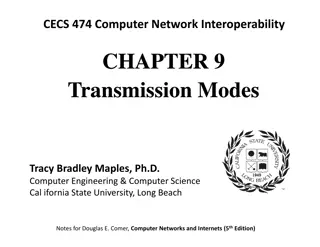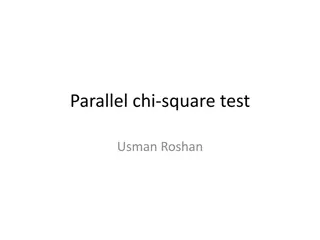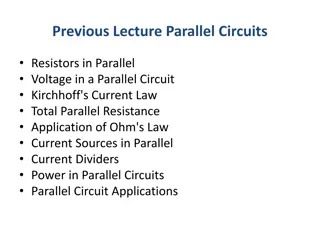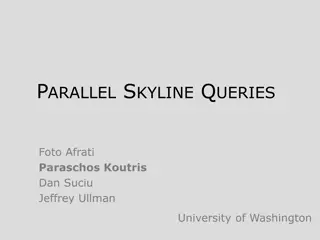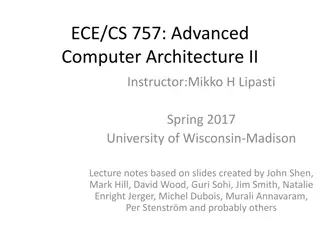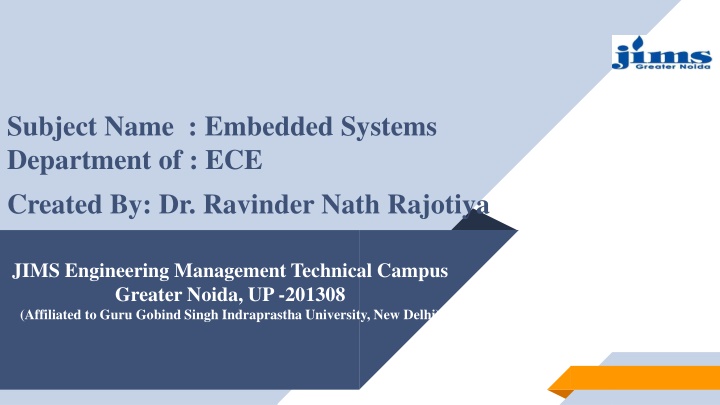
Exploring Embedded Systems Department of ECE and ARM Serial Parallel Communication
Discover the world of Embedded Systems at the Department of ECE, created by Dr. Ravinder Nath Rajotiya at JIMS Engineering Management Technical Campus. Dive into topics like ARM Serial Parallel Communication, Communication Protocols, Transmission Modes, Clock Synchronization, and more. Learn about Serial and Parallel Communication Protocols, Transmission Modes, and Clock Synchronization in detail to enhance your understanding of embedded systems.
Download Presentation

Please find below an Image/Link to download the presentation.
The content on the website is provided AS IS for your information and personal use only. It may not be sold, licensed, or shared on other websites without obtaining consent from the author. If you encounter any issues during the download, it is possible that the publisher has removed the file from their server.
You are allowed to download the files provided on this website for personal or commercial use, subject to the condition that they are used lawfully. All files are the property of their respective owners.
The content on the website is provided AS IS for your information and personal use only. It may not be sold, licensed, or shared on other websites without obtaining consent from the author.
E N D
Presentation Transcript
Subject Name : Embedded Systems Department of : ECE Created By: Dr. Ravinder Nath Rajotiya JIMS Engineering Management Technical Campus Greater Noida, UP -201308 (Affiliated to Guru Gobind Singh Indraprastha University, New Delhi)
Subject : Embedded Systems Topic: : ARM Serial Parallel Communication
Outline Serial Communication: Example usage Serial and parallel Communication Protocols Transmission Mode Synchronous Vs Asynchronous Basic Terminology Parallel Bus: AMBA AHB
Synchronous Serial Input/Output Example : Synchronous Serial Input Example : Inter-processor data transfer, reading from CD or hard disk audio input, video input dial tone network input transceiver input scanner input remote controller input serial I/O bus input writing to flash memory using SDIO (Secure Data Association IO based card) Example Synchronous Serial Output: Inter-processor data transfer, multiprocessor communication writing to CD or hard disk audio Input/output video Input/output dialer output network device output remote TV Control transceiver output serial I/O bus output or writing to flash memory using SDIO
Communication Protocols Parallel Communication Protocols. ISA-industry standard arch ATA SCSI PCI IEEE-488. Serial Communication Protocol CAN ETHERNET I2C SPI RS232 USB 1-Wire and SATA
Transmission Modes in Serial Communication There are several types of serial communication depending on the type of transmission mode and data transfer. The transmission modes are classified as Simplex, Half Duplex and Full Duplex
Clock Synchronization Synchronous Serial Interface The data transmission becomes faster with same bus to share clock and data. Also there is no mismatch in baud rate in this interface. In transmitter side, there is a shift of the data onto serial line providing the clock as a separate signal as there is no start, stop and parity bits are added to data. The well-known examples are I2C and SPI. Asynchronous Serial Interface In asynchronous Serial Interface, the external clock signal is absent. The Asynchronous Serial Interfaces can be seen in mostly in long distance applications and are a perfect fit for the stable communication. In asynchronous Serial Interface the absence of external Clock Source makes it rely on several parameters such as Data Flow Control, Error Control, Baud Rate Control, examples are RS-232, RS-422 and RS-485.
Terms Used Baud Rate: Baud rate is rate at which the data is transferred between the transmitter and receiver in the form of bits per second (bps). The most commonly used baud rate is 9600. Other baud rate such as 1200, 2400, 4800, 57600, 115200 also used. The more the baud rate faster will be the data transferred at a time. The baud rate has to be same for both transmitter and receiver. Framing: Framing is referred to the number of data bits to be sent from transmitter to receiver. The number of data bits differs in case of application. Most of the application uses 8 bits as the standard data bits but it can be selected as 5, 6 or 7 bits also. Synchronisation: Synchronization Bits are important to select a chunk of data. It tells the start and end of the data bits. The transmitter will set start and stop bits to the data frame and the receiver will identify it accordingly and do the further processing. Error Control: The error control plays an important role while serial communication as there are many factors which affects and adds the noise in the serial communication. To get rid of this error the parity bits are used where parity will check for even and odd parity. Protocol is just like a common language that system uses to understand the data. As described above, the serial communication protocol is divided into types i.e. Synchronous and Asynchronous. Now the both will be discuss in detail.

